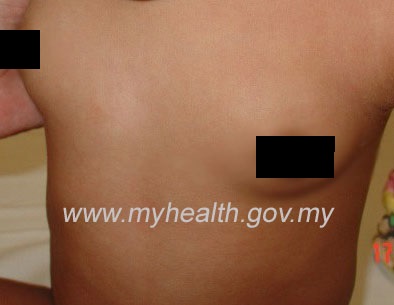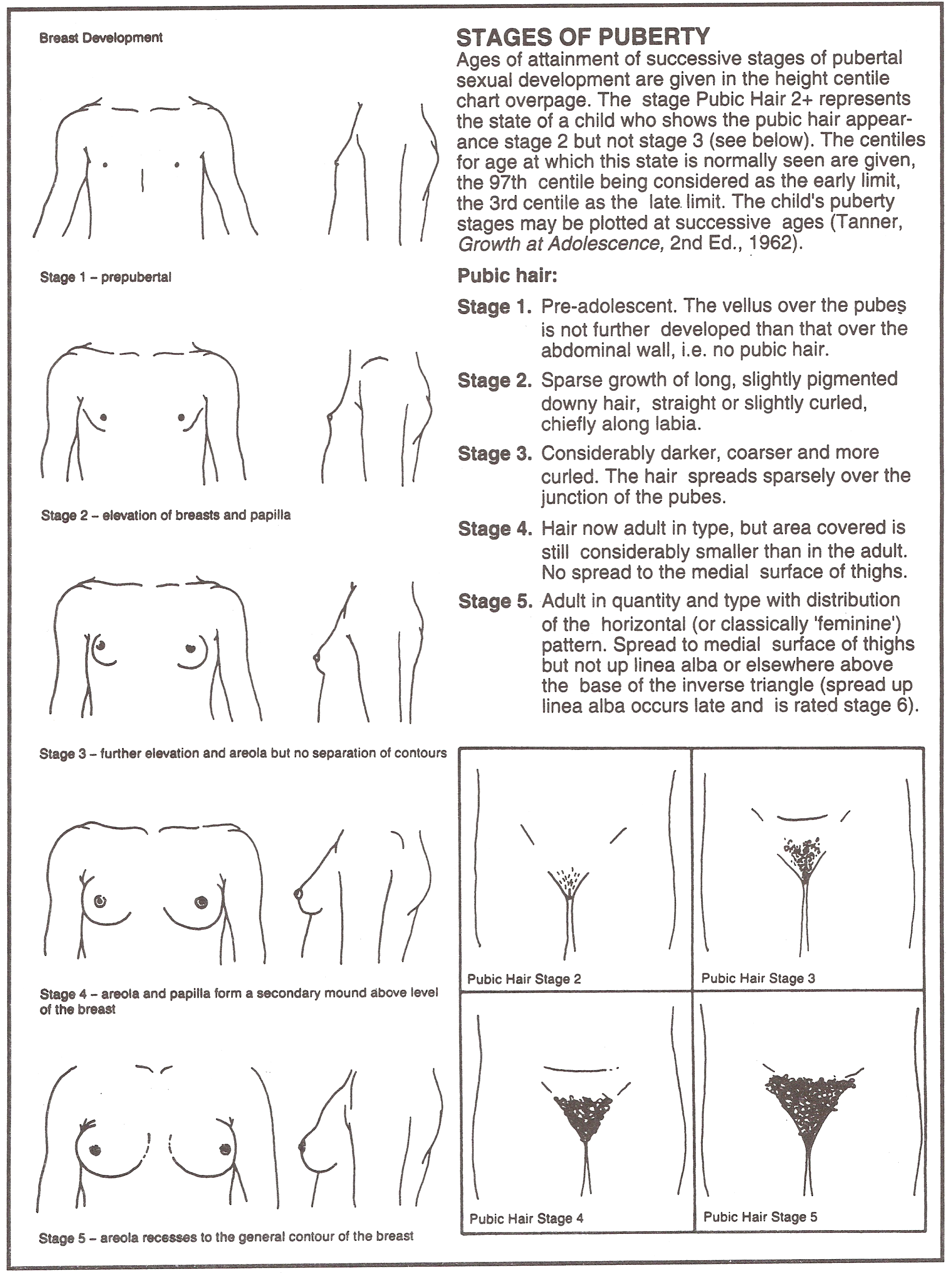When is breast enlargement in a girl considered too early?
The normal process of puberty in a girl starts from 8 years of age with breast development. This is followed shortly by growth spurts and later other secondary sexual characteristics. Refer figure 1.
Girls who show breast enlargement before 8 years of age are considered too early. However, certain ethnic group are associated with earlier pubertal onset, such as the African American who are reported to have earlier breast development starting from 6 years of age.

Figure 1: Breast enlargement
What is the commonest cause of early breast enlargement in a girl?
There are many possible causes for early breast enlargement in a girl and one of the commonest cause is premature thelarche.
Premature thelarche occurs when a girl begins to show breast enlargement at an early age. The onset of breast enlargement is usually anytime between infancy to two years of age, and rarely after 4 years of age.
While troubling for parents, it is benign and most cases regress 6 months to 6 years after the diagnosis. This condition may fluctuate but it does not progress, and is not associated with growth spurt. It certainly does not progress to menstrual bleed. There is no other secondary sexual characteristic such as axillary or pubic hair or other signs of puberty. It does not require treatment but should be evaluated to rule out other causes.
What causes premature thelarche?
Premature thelarche is considered to be due to excessive sensitivity of the breast tissue to the low levels of oestrogen or due to minimally elevated pre-pubertal oestrogen level. Unlike true puberty, it is not activated by the brain.
It is a benign condition and child will subsequently enter puberty in a normal fashion. Later pubertal milestones are attained at expected ages and final height potentials are not altered.
How is premature thelarche diagnosed?
Premature thelarche is diagnosed in a girl with the following features:
- A girl with enlargement of one or both breasts and no other signs of sexual maturity (no acne, axillary, pubic hair or menstrual bleed).
- Occurs between infancy to two years of age, and rarely after 4 years of age
- Growing at a normal rate, just like her peers.
- Vaginal mucosa appeared thin and reddish and non-oestrogenized.
- A radiograph of the left wrist may be done to assess bone maturation. Bone age is not advanced in premature thelarche. (A rapidly progressing precocious puberty is associated with advanced bone age. Early breast enlargement due to untreated hypothyroidism is associated with stunted growth and delayed bone age)
- Ultrasound may be done and will show a prepubertal size uterus.
- Laboratory studies are not necessary for the diagnosis. Girls with premature thelarche do not have elevated blood levels of oestrogen and luteinizing hormone, though they may have greater follicle-stimulating hormone secretion. Thyroid function tests may be done if hypothyroidism is suspected.
How to treat premature thelarche?
Premature thelarche is self-limiting and not associated with any complications. Therefore, treatment is not necessary.
There is a small chance that the girl diagnosed with premature thelarche (non-progressive) is actually starting puberty (progressive precocious puberty). Since breast development in a girl can also be the first finding of progressive precocious puberty, parents must understand the importance of subsequent clinic follow-ups to monitor child’s physical and growth.
Parents should address their child’s concerns and provide reassurance and simple explanation to decrease their anxiety or fears.
What are other causes of early breast development?
Other causes of early breast development:
The initial history and physical findings in premature thelarche are often inconclusive. Furthermore, early breast development may also be the first finding of other forms of progressive precocious puberty.
Thelarche variant is variation of premature thelarche. Age of presentation is usually older in comparison to premature thelarche. Cyclical breast growth may be seen, which does not resolve spontaneously. It is a slowly progressive variant of precocious puberty in girls. Children with this condition may advance slowly with accompanying growth acceleration and bone age advancement.
Precocious puberty can be due to activation by the brain (central precocious puberty) or by peripheral sources (ovaries, adrenals). Precocious puberty is progressive (increasing breast size, pubic/axillary hair, menstrual bleed) and associated with growth spurt. Further investigations (blood tests and imaging studies) are needed to identify various treatable causes of precocious puberty.

Figure 1: Stages of puberty in girls
Reference:
- Handbook of clinical pediatric endocrinology. Charles G.D.Brook and Rosalind S.Brown. First Edition 2008. Blackwell Publishing. ISBN-978-1-4051-6109-1
- Paediatric Endocrinology, the requisites in Pediatrics. Thomas Moshang, First Edition 2005. Jr. Elsevier Mosby. ISBN 0-323-01825-4
- pediatricweb.com/webpost/iframe/MedicalConditions_487.asp Kappy MS, Ganong CS. Advances in the treatment of precocious puberty. Adv Pediatr 1994;41:223-61. Copyright 2012 Michael S. Kappy, M.D., Ph.D.,
| Last Reviewed | : | 28 August 2020 |
| Writer | : | Dr. Janet Hong |
| Accreditor | : | Dr. Fuziah bt. Md. Zain |
| Reviewer | : | Dr. Zainab bt. Kusiar |







